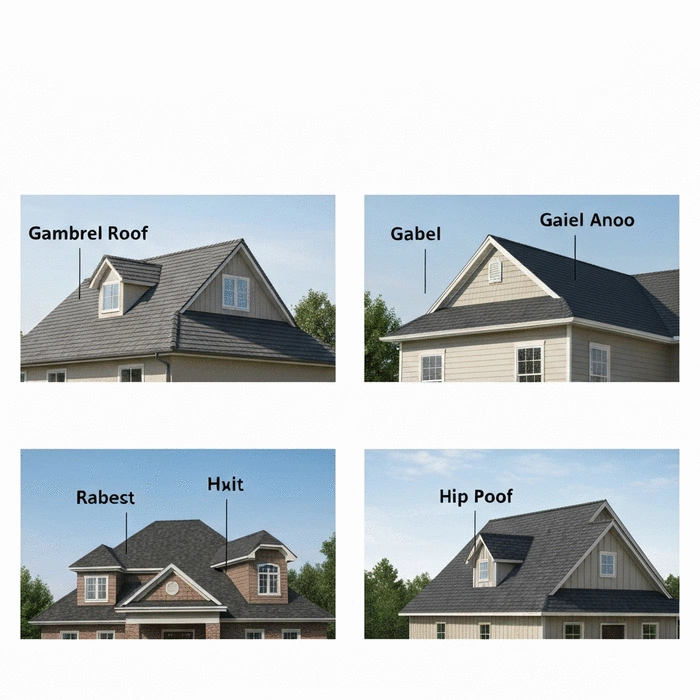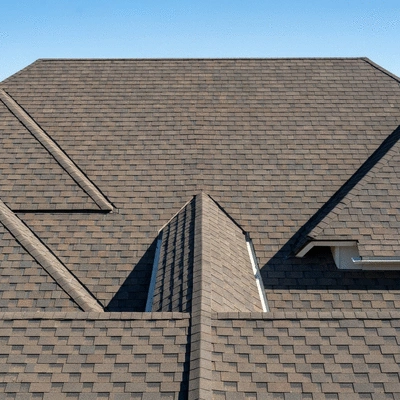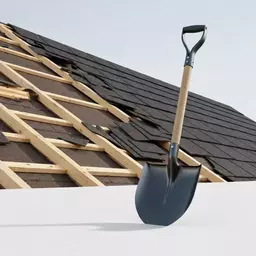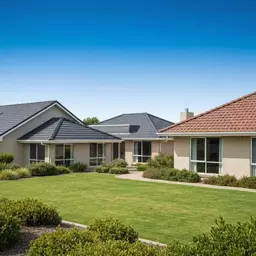Gambrel Roof
- 1Distinctive barn-like appearance with two slopes per side.
- 2Maximizes attic space for storage or living.
- 3Can be more cost-effective due to fewer material requirements.
Get Jordan M. Knox's latest insights on roofing materials, maintenance, and expert tips delivered directly to your inbox. Stay ahead of the curve!
Posted on: 2025-11-02
By: Jordan M. Knox
Choosing the right roof shape can significantly influence your home's appearance and functionality. As you navigate through various roofing styles, it's essential to understand their unique characteristics and benefits. This knowledge will empower you to make an informed decision that not only enhances your home’s aesthetic but also meets practical needs!
A side-by-side comparison of Gambrel, Gable, and Hip roofs, highlighting their key features and benefits.
When it comes to roofing, the shape of your roof plays a critical role in both aesthetics and functionality. Today, let's dive into the three popular roof shapes: gambrel, gable, and hip roofs. Each of these styles boasts unique characteristics that can significantly impact your home's look and performance.
Understanding these key features can guide you in making an informed decision for your residential roofing needs. Ready to learn more? Let's explore the various roof styles, pros, and cons!
The gambrel roof is perhaps best known for its distinctive, barn-like appearance. This roof style features two slopes on each side, with the lower slope being steeper than the upper one. This design not only looks charming but also maximizes space in the attic.
As a roofing expert, I often recommend gambrel roofs for homeowners looking to blend style with functionality. They really are a perfect choice for those who want to combine aesthetics with practicality!
The gable roof is another classic option that features two sloping sides forming a triangle at the top. This simplicity makes it one of the most popular roof shapes in residential construction.
Many homeowners love the gable roof for its balance of aesthetics and practicality. Plus, it provides ample space for ventilation and insulation, which is a huge plus for energy efficiency! For more insights into different roof types, check out our guide on roof types every homeowner should know.
Now let’s talk about hip roofs, which are characterized by slopes on all four sides that meet at a ridge. This design offers a more stable structure compared to gable roofs, making it a preferred choice in areas prone to high winds or heavy snowfall.
As a roofing professional, I appreciate the hip roof for its robustness and versatility. It’s a fantastic option for homeowners looking for a blend of durability and style!
When selecting a roof shape, consider not only the aesthetic appeal but also how it impacts energy efficiency. For instance, a gable roof provides excellent ventilation, which can help regulate attic temperatures and reduce cooling costs during the summer. Additionally, exploring sustainable materials can enhance both your home's environmental footprint and its market value!
When it comes to choosing a roof, the design and aesthetic options available can truly transform the look of your home. Different roof shapes not only affect functionality but also play a significant role in your home's overall curb appeal. With the right roofing style, you can enhance the character of your property and make it stand out in the neighborhood!
Roofing shapes come in a variety of styles, each adding its unique touch to your home. Let's take a look at some popular variations:
Each style can complement different architectural designs, so it's crucial to choose one that harmonizes with your home's aesthetic. For example, a Dutch gable roof might be ideal for a craftsman-style home, while a clipped gable could work well with more traditional designs.
Your home's architecture is an essential factor in determining the roof style that will work best. Consider these points when making your choice:
At Roofing Explained, we understand that selecting the right roof is a significant decision. That's why I encourage homeowners to visualize how different styles might look on their properties. You can use software or even sketching to help you make the best choice!
Home design trends are constantly evolving, and roof shapes are no exception. It's fascinating to see how architectural styles have changed over the years! Here are a few trends that are shaping today's roofing aesthetics:
Staying in tune with these trends can help you choose a roof that not only meets practical needs but also keeps your home stylish and appealing. Remember, a well-designed roof enhances not only your home's aesthetic but also its value!
With so many options available, making an informed decision about your roof shape is essential. There are various factors to consider, each impacting both function and style.
The energy efficiency of your home can be heavily influenced by your roof shape. For example, roofs with steep pitches like gables allow for better ventilation and can keep your attic cooler during hot months. Here are some considerations:
Evaluating these elements can help you create a more energy-efficient home that saves you money in the long run.
Sometimes, visual aids can make all the difference in understanding how different roof shapes will impact your home. When discussing options with contractors or architects, it’s useful to refer to:
At Roofing Explained, I often recommend bringing these tools into discussions to ensure everyone is on the same page!
Before settling on a roof shape, it's crucial to familiarize yourself with local building codes and neighborhood guidelines. These regulations can dictate aspects of your roof, such as:
By understanding these codes, you can avoid potential issues and ensure your new roof complies with regulations.
As you consider your roof's design, it's essential to weigh the benefits of attic space against the durability of the materials and shape. Balancing these two factors will help you make a choice that meets both your functional and aesthetic needs.
A1: Gambrel roofs feature two slopes on each side with a steeper lower slope, maximizing attic space and offering a barn-like aesthetic. Gable roofs have two sloping sides forming a triangle, providing excellent water drainage and versatility. Hip roofs have slopes on all four sides meeting at a ridge, offering superior stability and additional attic space.
A2: Roof shape significantly impacts energy efficiency through ventilation and insulation. Steep pitches, like those found in gable roofs, often allow for better ventilation, which can help regulate attic temperatures and reduce cooling costs. Proper insulation suitable for the roof type is also crucial for maintaining stable indoor temperatures.
A3: Local building codes and neighborhood guidelines are essential because they dictate aspects such as roof pitches, heights, and material types. Adhering to these regulations ensures your new roof complies with legal requirements, avoiding potential issues, fines, or the need for costly modifications later on.
A4: Yes, many hip roofs can provide additional attic space similar to gambrel roofs. This space can often be converted into a loft, an extra room, or used for storage, adding significant value and functionality to your home.
A5: Current trends include minimalism with clean lines and flat roofs, sustainable designs utilizing eco-friendly materials and energy-efficient structures, and the use of mixed materials for unique visual interest. These trends focus on balancing practical needs with modern aesthetic appeal.
Sometimes, it's best to engage with professionals who can provide tailored advice for your roofing project. If you're feeling overwhelmed, consider reaching out for guidance on:
Don’t hesitate to seek help! Finding a qualified contractor can make all the difference in achieving your desired results. For more information on maintaining your roof, refer to our comprehensive roof maintenance inspection guide.
Lastly, consider your preferences and potential resale value when choosing your roof shape. While personal taste is important, it's also wise to think about:
Ultimately, the roof you choose should reflect your style while also being a smart investment for the future!
Here is a quick recap of the important points discussed in the article:



 Ever faced the daunting task of removing old roof shingles? The right tool can transform this labor-
Ever faced the daunting task of removing old roof shingles? The right tool can transform this labor-
 Have you ever stopped to think about how your local weather might be silently dictating the lifespan
Have you ever stopped to think about how your local weather might be silently dictating the lifespan
 Have you considered how your roof can affect your home's comfort and energy efficiency? Understandin
Have you considered how your roof can affect your home's comfort and energy efficiency? Understandin